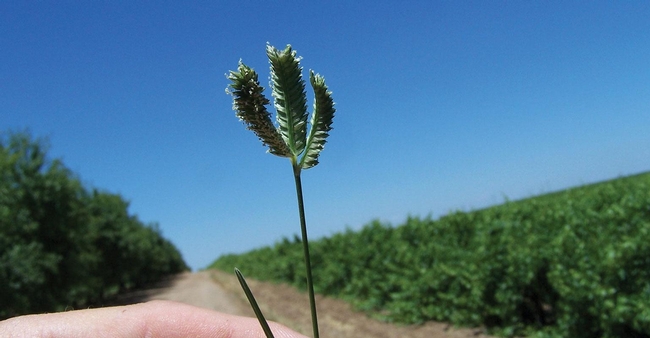From the Western Farm Press • March 17, 2021
By Lee Allen
**********
Recurring, multiple-resistance species are among the biggest challenges.
Brad Hanson gets down and dirty in his line of work as a weed specialist with the University of California, Davis Plant Sciences Department, typically conducting field trials in a 400-mile swath of the Central Valley.
He's on the cutting edge when it comes to herbicide use patterns, herbicide resistance, and new weed problems to add to tree nut growers radar screens.
If he's not in a field chasing new weed species, he's looking for better ways to combat existing ones. “There's not been a lot of change in herbicide use in the tree and vine sector over the last decade, few changes in the active ingredients,” he notes when discussing glyphosate and oxyflurofen as the top two, year-in and year-out, most commonly-used herbicides across all tree crops.
“Over the last five years, there's been a minor decrease in glyphosate acreage and my assumption is that it's market preference moving a bit away from that particular herbicide in favor of greater use of pre-emergents.”
In a presentation titled, “Orchard Weed Management Update for Almonds,” Hanson said: “While there's been a lot of recent attention being paid to a summer-emergent grass called jungle rice and three-spike goosegrass, the weed I get the most questions about is alkali weed. It's not a widespread problem, but if you have it, it becomes a big problem because it's a perennial that dies back to the crown in the fall and regrows underground from last year's plant.
“I've found a lot of it in pistachio orchards in the San Joaquin Valley,” he said. “It's hard to whack because it's so hairy and it's very tolerant of glyphosate. Because it's a perennial, it's difficult to control without pre-contact herbicides or pre-emergents, and once it's established, we don't have a lot of eradication tools at our disposal. This is one that can be really problematic.”
A bigger issue may be multiple-resistance species that are already resistant to the No. 1 post-emergent program (glyphosate) that develop a secondary resistance to a different mode of action.
‘A temporary solution'
“As a grower, you need to beware that simply switching to another pre-emergent herbicide may only represent a temporary solution,” he said. “If you see resistance to two pre-emergent herbicides, that's the real thing.
“Like three-spike goosegrass, a short-lived perennial that emerges in the spring or early summer and dies back in the winter. It's very low-growing, less than 10 inches, so it tolerates mowing well and is a prolific seed producer. It's also very tolerant of glyphosate, especially if it's already established. I'd describe this one as a relatively early stage problem in the Central Valley, northern Sacramento Valley, and middle San Joaquin. It's definitely around and worthy of a pre-emergent program as seedlings are more easily managed.”
Weeds are always a problem for growers and are especially so as orchards expand into new acreage and “expansion weeds” are discovered, Hanson explains. “These are weeds that were common in the previous grazing land. For the most part, they cycle out of the system after a few years of orchard weed management, but some can be quite difficult problems to eradicate.”
While glyphosate is an important management tool—“a lot of bang for your buck over a wide weed spectrum” —other options are available to accomplish the management goal, although cost might increase to some degree as that herbicide has been off-patent for a number of years, he said.
“The good news is you won't have to worry about glyphosate-resistant weeds, now you'll get to worry about all of them,” he said. “We need to think closely about our approaches to weed management, our goals and tolerances in the orchard. What are the specific weeds we are encountering? What are their week points in their lifecycle where we can time our management approaches, either physical or chemical. We need to use the right tools for the job at hand, not just a bigger hammer which can get you in trouble from a regulatory and economic standpoint.”
Original source: Western Farm Press • March 17, 2021
